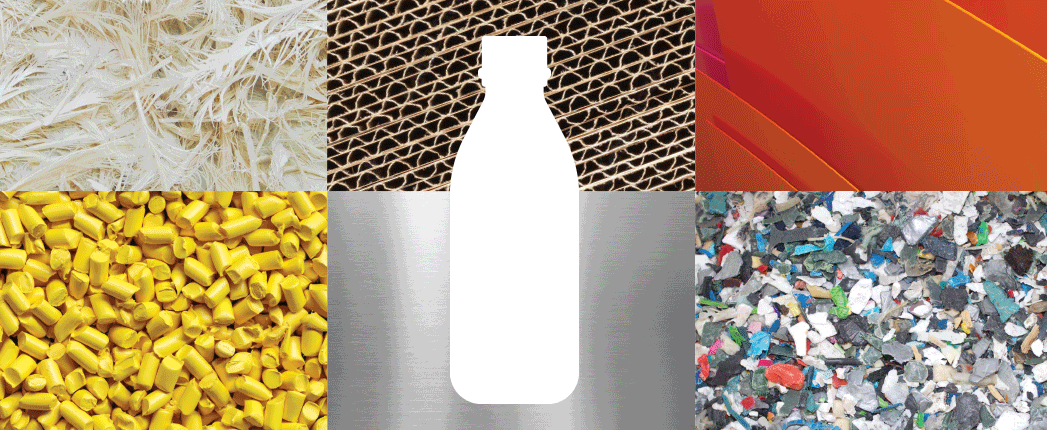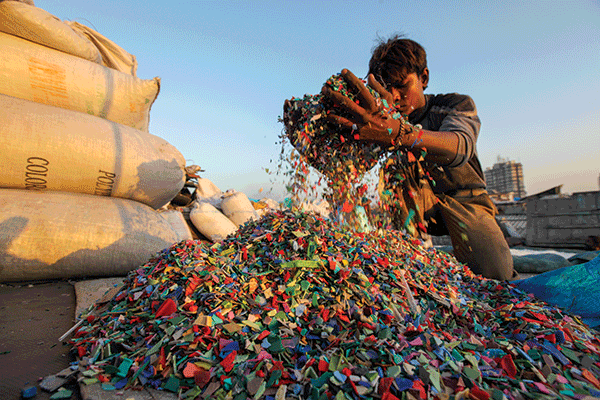
There is a never-ending effort to improve motor oils. Companies and organizations year-round work to identify the benchmarks needed to meet the demands of the modern engine, then formulate a product that meets or exceeds those specifications. Scores of groups are also working on the materials that contain those lubricants. The design needs of lubricant packaging ranges from ergonomics to sustainability to cost-saving measures.
How far have we come, where are we now, and where are we going with lubricant packaging?
Packaged engine oil can be traced back to the early 20th century, when it was contained in cylindrical tin cans. By the mid-20th century, oil cans came in all shapes and sizes. Cardboard cans were introduced, the first iterations of which had a cardboard body with a metal top and bottom. Later, these types of containers were fully made of cardboard. Aluminum was also used. At this point, companies were selling their products in cylindrical, square and rectangular containers, which could range from half a gallon up to five-gallon volumes.
The first plastic containers would come soon after. A Los Angeles Times article from 1985 documented Quaker State’s transition from cardboard cans to plastic containers. Adding motor oil to an engine from a tin or cardboard can requires an oil spout to open the container, and possibly a funnel to pour it into the crankcase, the article explained. Meanwhile, plastic bottles have screw-top lids and a long neck for an easier pour.
Specifically, modern lubricant packaging is mostly made of high-density polyethylene, or HDPE, which is also used in milk jugs and water bottles.
Steve Ruble, principal packaging engineer at Valvoline, joined the company as it developed the second iteration of its plastic bottle design in 1995. He has been part of six different iterations since then, and all have used HDPE.
Why HDPE? Simply put, HDPE provides several advantages over other materials.
“It is a lightweight product. It’s unbreakable. It keeps the product out of the environment and the environment out of the product. It really is the perfect solution for motor oil,” Ruble told Lubes’n’Greases.
“Glass is too expensive, it’s too fragile, it’s too heavy. It’s hard to deal with,” he continued. “Aluminum is too fragile. Steel probably would work, but it’s expensive, most economical in a round container—which isn’t very user friendly—and you have to have some other device that allows you to help you pour it.”
Beyond its end use as a motor oil bottle or bottle of detergent, HDPE has a relatively low melting point, is easily processed and is highly recyclable. “If recyclers handle it properly, it has an extremely long life cycle,” Ruble said.
Another area where HDPE shines is coloring. The motor oil aisle at your local auto parts dealer will be the most colorful in the store. Castrol and Quaker State’s products can be found in highly recognizable green bottles, Pennzoil’s in yellow, and most sellers will have mainline and specialty brands that can come in black, white, gold, silver, red or blue.
Despite its utility, the use of plastic has come under fire in recent years as sustainability efforts in all industries has ramped up.
“People who want to get rid of plastics completely don’t understand the value,” Ruble said.
The only downside to HDPE that Ruble mentioned is that it does have a certain level of absorption, meaning the oil can absorb into the walls of the packaging, discoloring it and making it harder to process. However, this process takes years.
In terms of ergonomics, when Ruble started in 1995 the bottle was more angular and used a little bit more plastic to make up the corners and edges of the oil bottles. Now, bottles use softer transitions in the constant effort to make bottles lighter weight, even by two or three grams at a time. Going even further back, the industry realized an oblong bottle provided better palette utilization compared to circular packaging that left so much open space between the circles in the palette.
Other practical design factors come into play, too. Independent blender Fuchs Group announced a new kind of small packaging for engine oils in late 2021, touting that the bottles are “more gentle on resources” and that the shape of the bottle makes it possible to pour out “even the smallest remaining volume of lubricant.” According to the company, this allows for complete emptying of the bottles, which it also says are 100% recyclable. These kinds of design features are constantly studied by packaging divisions.
Making lubricant packaging more sustainable is far from easy. Sustainability has become the key topic of the lubricants industry during the past few years, but it already affected packaging design well before that. California laws require that plastic containers are made of at least one-quarter recycled content, meaning a blender is more well-served making all their containers compliant rather than marking out specific bottles to be sold in California.
Now, the average bottle can contain about one-quarter to one-third of recycled materials, but it is not as simple as increasing that ratio.
“We have experimented with a greater [recycled] content. And we can make a pretty good bottle up to about 70%,” Ruble said. “With all that said, there are some downfalls with going too high with post-consumer resin. But the biggest one really is cost.”
More states and countries are adopting similar measures as California, making recycled material scarcer and driving up the price. While state legislators are doing a good job of passing these kinds of laws, they are not adequately funding or supporting the recycling industry to process materials in an economical manner, Ruble said.
Instead, advancements for sustainability in packaging will more likely come from recycling the plastic containers. However, it’s a complicated process to do so.
The National Lubricant Container Recycling Coalition is looking at ways to make that process easier. Valvoline is one of a few founding members of the coalition, and Ruble is on one of the coalition’s working groups. The other founding members are Castrol, Pennzoil-Quaker State and packaging companies Graham Packaging and Plastipak Packaging.
The biggest challenge is that used lubricant bottles contain residual oil that can affect the recycling process and make empty containers less valuable. Most bottles end up in landfills.
The coalition launched its first pilot project last August—a one-year study covering over 40 locations in Atlanta, Georgia, including retail stores, auto care centers and quick lube stations. The pilot aims to figure out and measure the economic and market drivers for post-consumer recovery and recycling, as well as to better understand consumer waste disposal behaviors.
Castrol has made a couple of gains on the sustainability front. In October, the company introduced 100% recycled plastic bottles in India, which has strict regulations requiring companies to ensure environmentally sound management of products through the end of the product’s life, including its packaging.
The bottles are made solely from post-consumer plastic resins, while the caps are still made from virgin plastic.
“The main challenges to using 100% PCR plastic is in obtaining suitable quality and quantity of PCR,” Jackie Poole, BP media relations manager, told Lubes’n’Greases in November. “HDPE, which is easily recyclable and used in PCR, is not collected as consistently as polyethylene terephthalate, which is currently used in many plastic bottles.
“Another challenge with PCR is its odor—which we have worked to avoid—and that use of PCR can influence the bottle’s color and strength. All the factors are dependent on source and supplier capabilities, both PCR and blow-molding suppliers, as well as the core bottle design’s strength.”
The company said customers won’t incur any additional costs to use the bottles, though it did decline to say if the recycled resins cost more than virgin plastic.
Additionally, Castrol announced a partnership with packaging company Pulpex in May 2021 to design paper containers for use with Castrol’s lubricants. Pulpex has developed a technology that forms bottles from wood pulp using 100% renewable feedstocks, and it claims that the paper bottle offers a lower carbon footprint that is up to 30% less than that of PET.

Mumbai, Maharashtra, India. Plastic recycle units in Asia’s largest slum. Last year, India passed legislation prohibiting businesses from using single-use plastics to combat its plastic waste problem. © Parikh Mahendra N / Shutterstock.com
“We’re very excited to be working with Pulpex to explore how their technology can be developed for lubricants as a replacement for our existing HDPE bottles,” A.S. Ramchander, Castrol’s chief marketing officer, said in a news release.
According to Pulpex’s website, the bottles are formed by pressurizing pulp in molds using highly advanced technology. The pulp containers are then cured in microwave ovens before being sprayed internally with specialized coatings designed to be compatible with the products they are holding. The company said it doesn’t use perfluoroalkyl and polyfluoralkyl chemicals in its packaging.
The bottles may be recycled the way paper products are typically recycled, the company said, and are designed to naturally degrade if they are not recycled or disposed of properly.
Will these kinds of efforts bear fruit, leading the way for change in the industry?
“It always changes; things always evolve,” Ruble said. “Frankly, we’re looking at other alternatives, even if they’re only part of the market. And I think everybody else is going to follow suit to a certain extent. We still all must make money; we have to stay in business. What we try to do is make our companies profitable. But with that said, with the value proposition of HDPE, I think it will always be used in some form.”
He continued: “This is why I’ve been really active in and was a huge advocate of starting the [NLCRC]. I know that the current packaging is the best for our industry. As an industry, we must figure it out, because we can’t count on a municipality or somebody outside of the industry understanding what value we can bring. So we need to create that system to be able to collect it, to recycle it, to reuse it and get it back into our consumers’ hands, so that we are all satisfied that we can provide a good product to our customers and we know that that we can be good stewards of our environment and meet any challenges thrown at us.”
Will Beverina is assistant editor for Lubes’n’Greases. Contact him at Will@LubesnGreases.com